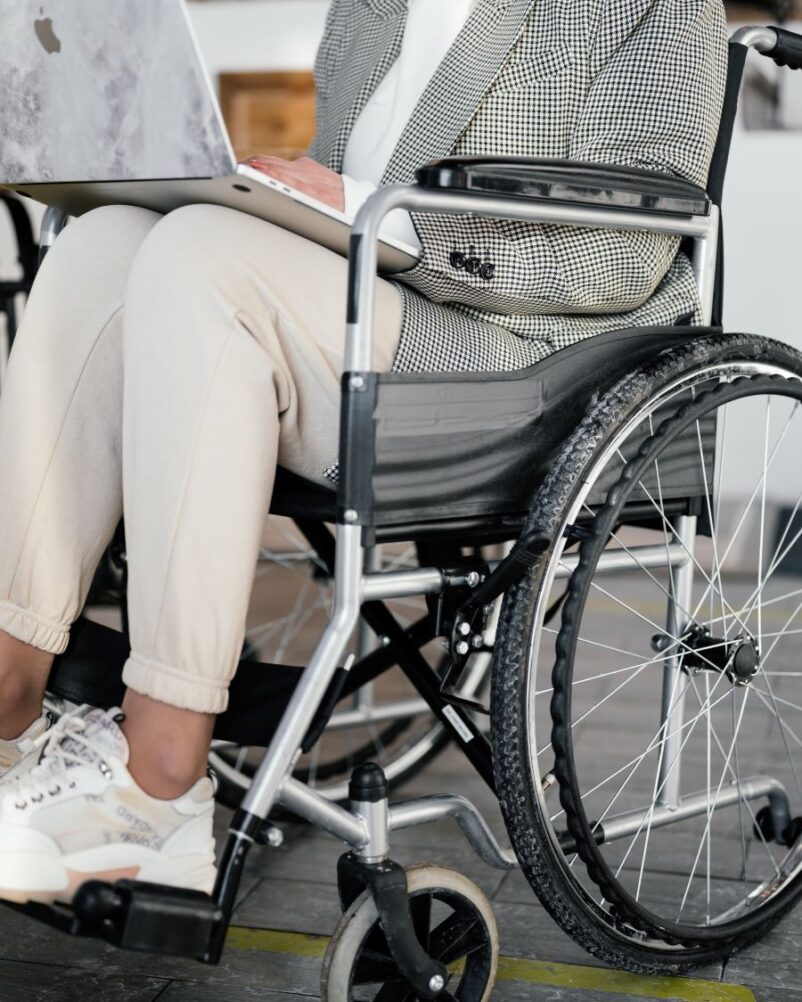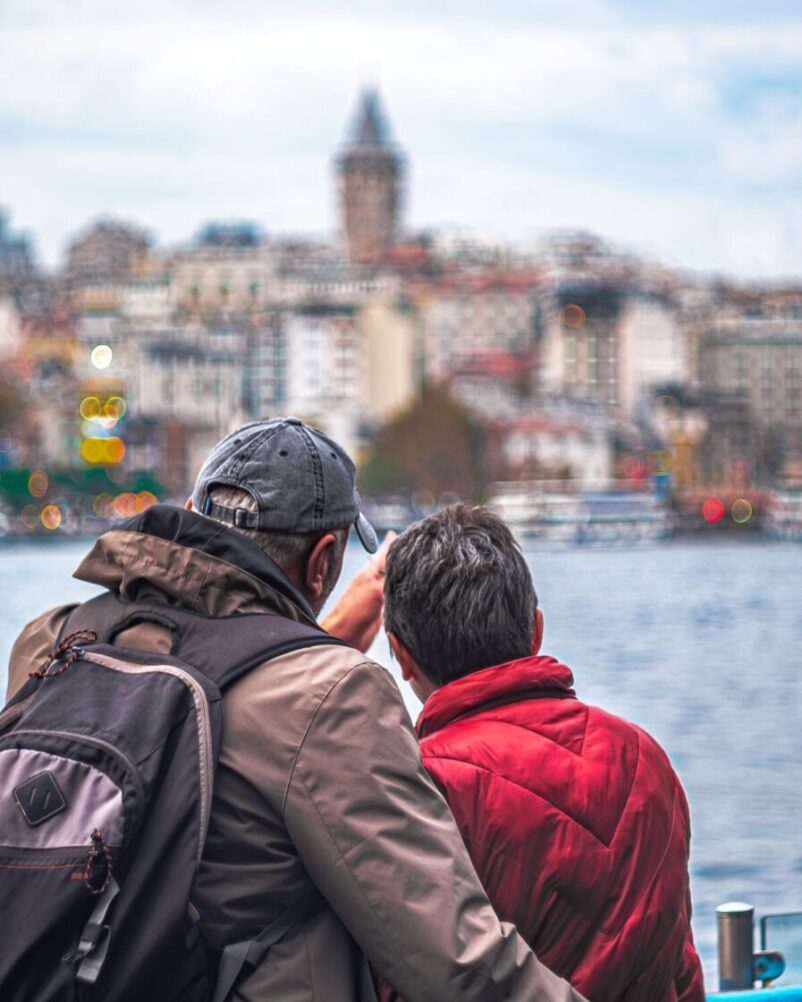
Do you want to travel abroad but have mobility challenges? Before you plan your next big trip to Europe or other overseas destinations, I’m here to tell you that mobility challenges require careful consideration before putting down the deposits. The advice in particular holds true when planning a visit to popular historical sites where streets and stairs were often created many hundreds of years (or more) ago.
I’m by no means saying you shouldn’t go to a particular place, only that careful consideration of your abilities and limitations are key. That’s because many sites aren’t equipped to safely accommodate those who are physically challenged. That’s why you should heed these travel to Europe tips so that you can return home safely and healthily.
Before diving into this topic, I want to differentiate between mobility challenges and having a disability. For this blog, I’m strictly referencing your ability to get around. For many overseas destinations, it means being on the go constantly, and at a fast pace at that. I’ll be discussing traveling with a disability in another blog, because it involves different considerations and goes beyond mobility.
So, why do many historic cities have such mobility challenges for individuals? A majority of quaint villages and cities have preserved cobblestone streets and other original surfaces, which can include gravel and dirt patches, because they are authentic and add to the charm. In a majority of areas, historical beauty comes with narrow (or none) sidewalk areas, competition between pedestrians and cars and scooters for pathways, and tons of stairs and uneven walking surfaces. If it rains or mists, then those surfaces become really slick.
In many cases, if you require use of a wheelchair, scooter, walker, or even just a cane, your trip will be more challenging. I’m not saying impossible by any means, and I’m not at all suggesting you should avoid the destination. Rather, I’m saying be warned and be prepared with these travel to Europe tips. Know your limitations. Consider your hotel and tours carefully. Then decide if traveling to a particular destination is right for you.
Mobility Challenges on Our European Adventure
My husband Rick and I (both in our early 60s), just returned from a vacation to various cities across Italy and to Paris. We both consider ourselves healthy, moderately fit, and able to move and walk at a fast pace. Having said that, there were many times during our multi-week stay that it was a struggle to safely navigate walking surfaces, getting on and off boats, and even going up and down the old and uneven stairs of some of the more popular sites.
While we did return healthy and without incident, we often were sore and achy throughout our three-week adventure. Even using some transportation alternatives at times like golf cart tours, taxis and Uber (when in Paris), we still walked over 70 miles during our trip. Of course, when going greater distances, we booked trains, tour bus, and ferries.
We also avoided booking the tours that said intense physical exertion is required, and thankfully so, because we found that tours saying “moderate exertion” was plenty for us. Even visiting the catacombs in Paris required going down a winding staircase into the underground, which then meant we had to traipse back up to ground level the same fashion. It wasn’t for the faint-hearted or short-winded folks, even with under 200 steps each way.
(Important side note: many places requiring that tourists climb or walk down levels have added the caveat that there is no ability to “take a break” while doing so. That’s because the corridors, steps, and walkways are often so narrow that if you stop, you are essentially keeping everyone else from getting to the top, or bottom. That means, once you commit to going, you’re in it. Keep that in mind.)
It was quite surprising on our trip to see such a high number of older individuals who weren’t faring very well with their mobility challenges. Crowded streets added to the risk, because you often really couldn’t see the surfaces clearly due to the number of people in order to navigate. Many of the streets are built on hillsides, and there are lots of walking bridges to go over canals. There were steps everywhere, and lots of them are carved from rock or a slick basalt or travertine.
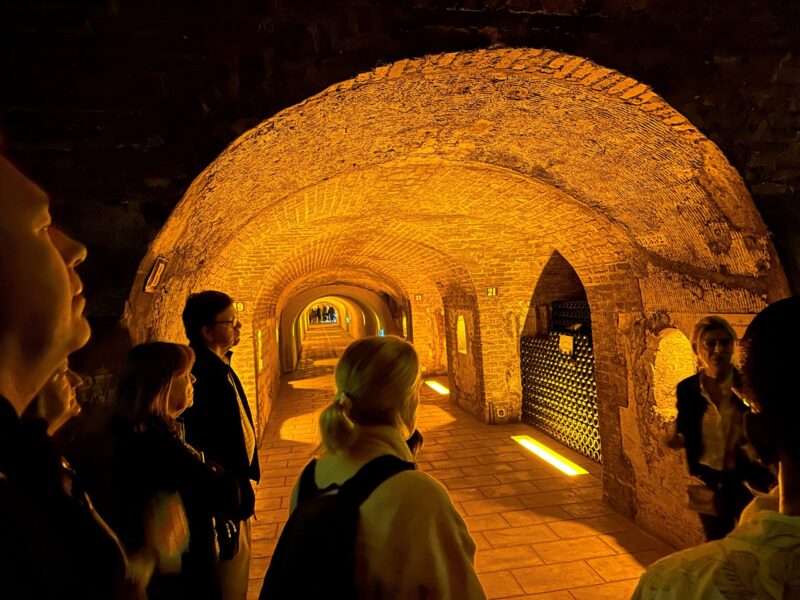 Interested in going on a wine or champagne tour? There are lots of steps going down to the cellars (often called caves). Cathedral? Some of the best views of the city are going up the Duomo (dome), and steps are small and uneven.
Interested in going on a wine or champagne tour? There are lots of steps going down to the cellars (often called caves). Cathedral? Some of the best views of the city are going up the Duomo (dome), and steps are small and uneven.
How about Rome’s coliseum? There are steps to the underground and steps up to the arena, followed by lots of steps to Palatine Hill. And riding a gondola in Venice? Be prepared to step down and walk to your seat on a shaky moving small boat … and one at a time so it won’t tip (so don’t look for a helping hand here). Many sites warn that you must be “moderately fit” and not claustrophobic. They aren’t kidding!
There is typically no provision for walkers, canes, or aids for any type of physical limitations, other than handrails (and not every place has those, either). Even visiting some famous piazzas and surrounding stores may involve hoofing it up and down some flights. Museums? Even same floor exhibits (and many large museums do have elevator access) often involve multi-levels to some degree. And, again, with Europeans’ love of marble, granite, and all things slippery, we found ourselves sometimes sliding on surfaces a tad, even on sunny days.
One of our favorite excursions was visiting the Amalfi Coast. It wasn’t for the faint-hearted or impaired walking, as from Rome the round trip meant taking two high speed trains and three ferry rides. The public transit systems required “rushing to board” once a platform was assigned at last minute, hurriedly finding your seat before the train took off, and then very quickly getting off before it took off again.
If you had luggage, that was another challenge, and don’t expect much, if any, help with that. But we did it. Since the charm of the villages meant they were built on the hillside, it also meant a lot of walking.
While in Positano, I did successfully make the climb practically straight up a hill to visit a lemon farm where they make the famous limoncello liqueur. However, it was quite exerting (not just for me, but others in our group as well). Handrails for navigating the hand-chiseled steps were only added in some areas.
Luckily, they bribed me with a lemon cake and lemon water as well as the liqueur at the top, and I have the agree the view was incredible. However, I was glad to reach the main level back down after that outing.
Flooring in Hotels Can Create Mobility Challenges
Hotel rooms, especially historic ones, seem to use lots of the marble flooring, which is beautiful to see but can be slick. It is so awe-inspiring to see the layouts of the rooms and lobby areas. However, at one hotel, we were upgraded to a stunning loft configuration. It was beautiful, but I nearly tumbled down the stairs one morning after I missed the first half-step turn.
While flooring wasn’t a deciding factor by any means (and it’s so much more beautiful and sanitary than old carpet), another of my travel to Europe tips includes avoiding wearing the comfy but oh-so-slick house slippers in a room with a slick surface. And, be ultra careful when getting in a shower that has the same flooring. I did do a Tom Cruise-style slide across the shower area one morning in the shower that thankfully, ended with just a giggle and nothing more.
Full disclosure: While certainly not mobility-impaired per se, I’ve had a “gimp” knee since twisting it skiing in my past. It sometimes buckles, so I was always conscious of my step. Rick has a hip that gets achy. Neither ailments kept us from doing everything we wanted, except that sometimes we literally just chose to sit for a minute when we could and take a short break.
Thinking a bit more on this, that’s not entirely true. We had signed up for a tour that included a timed entrance into the Florence, Italy, Duomo Tour with Brunelleschi’s Dome Climb AND Bell Tower Climb. After reading the description that each was about 400 steps and was a narrow walk, I opted out and my husband decided the same, mainly in support of me.
The decision was made with the details that included there were no landings or benches to catch your breath, if needed. But, we did the other elements of the tour, including visiting the spectacularly beautiful cathedral.
Also, there are other travel to Europe tips you should really consider.
7 Things You Should Know Before Heading Over to Europe with Mobility Challenges
- Many historic places of interest cannot accommodate individuals with mobility challenges.
Decide what type of trip you can realistically make and plan your itinerary accordingly. Carefully research the places that you want to visit concerning mobility challenges and plan a realistic itinerary that can safely accommodate your interests and needs.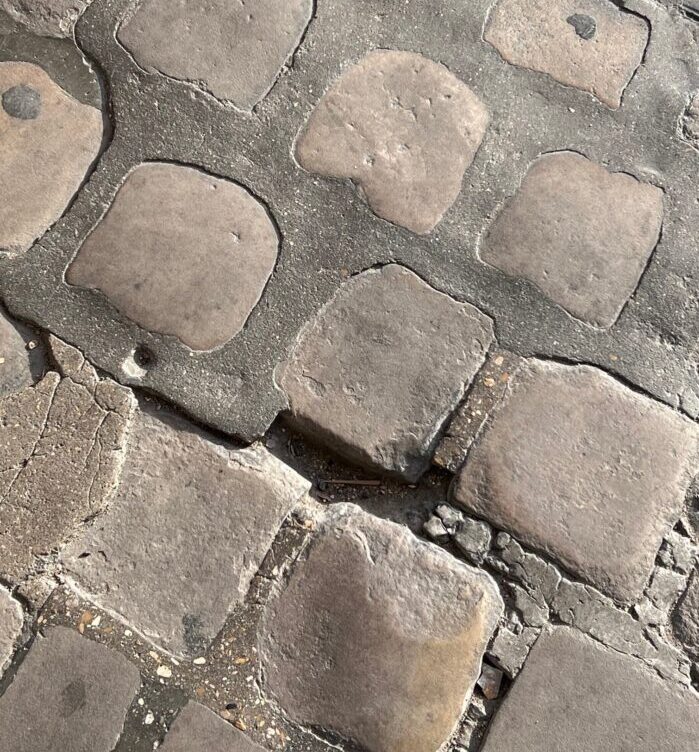
For example, if you plan to only visit major museums or the floor level of cathedrals, mobility won’t be a key concern. But if you have your heart set on climbing to the top of areas that tout “the best views of the city” or staying in a hotel that is on the side of the cliff, you might carefully analyze the mobility challenges you might face (as well as of your travel companion) before booking.
- Understand there can be mobility challenges in even the simplest of activities.
My gimpy knee held up for our journey, but it was because I really babied it a lot and made sure Rick was nearby in case I needed an arm for support. In spite of my being active overall, things like getting into water taxis and the gondola in Paris, or even stepping down from the train onto the platform at train stations required some extra thought on my part.Keep in mind that these “simple physical acts” aren’t mentioned as mobility issues in brochures or guides, so it’s up to you to know your limitations.
- Everything is hustle and bustle, and there’s no time for slow pokes.
Unless you book on a specific tour that caters to individuals who require a slow pace or have mobility challenges, don’t expect to be catered to. That’s a realization I really hadn’t thought through ahead of time.Tourists flocked to Europe in 2023 and are expected to do so again in 2024 and beyond. For locals catering to visitors, there are schedules to keep, crowds to navigate, and activities to maintain so that the experience is as promised and positive reviews are rewarded.
With that said, everywhere we went was crowded, and we went during the so-called “shoulder” season in October of this year. I understand it was even more crowded during the prime tourist season of summer.
The crowds mean you are constantly on the go, with timed entry times to make, tour guides to meet, and statues, paintings, cathedrals, and areas to see…along with everyone else.
If you are only able to walk at a slow pace, you could easily get left behind, or else take an unfortunate tumble or twist in your mission to keep up the pace. We saw many individuals who look like something may have happened in their adventure and were out in the piazzas with bandaged arms or sporting crutches.
My same-age friend suffered a nasty fall on her first day in Italy when she was on a family trip, and faced the rest of the time on crutches and in pain. So, it happens!
- Arrange for transportation to/from hotel and don’t be one of those individuals rolling your suitcases down the streets.
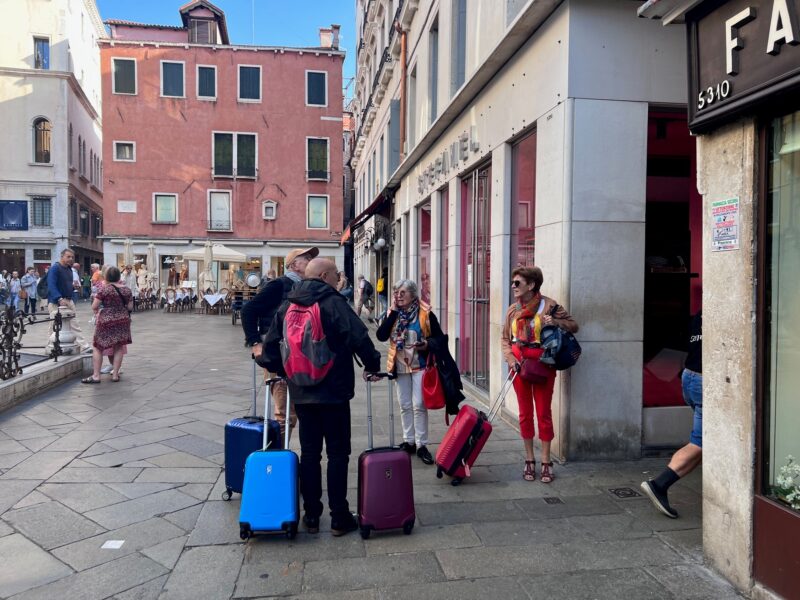 We saw this everywhere: people dragging their suitcases from the train station to hotel. If you can avoid doing so by taking a taxi or other public transportation office, trust me. It’s worth it. Now, don’t get all mad at me for saying this, please.
We saw this everywhere: people dragging their suitcases from the train station to hotel. If you can avoid doing so by taking a taxi or other public transportation office, trust me. It’s worth it. Now, don’t get all mad at me for saying this, please.There were plenty of younger, active individuals who seemed to have only small bags and were quite seasoned with doing this. In that case, go for it. But, more often than not, there were individuals lugging overly large, wheeled suitcases, fighting uneven surfaces and having to lift and lower their gear constantly.
If you didn’t understand it before, let me re-emphasize that sidewalks (where there are some) tend to be narrow and often in disrepair as well. Add in that are crowds of people on those same sidewalks, and all seem to be in a hurry. The streets are typically filled with cars and fast moving scooters and motorcycles, and none have the time or patience to wait out for slow-moving, overly packed individuals trying to cross the streets.
While a hotel being only a mile from the train station may sound good in theory and a way to save some Euros when you are on a budget, be realistic about your abilities.
If still electing to make the hike with baggage, have a Plan B in place in case your initial walks with suitcases ends up with a broken wheel or handle in the process. (Trust me, it happens.)
Not all tour groups are created the same.
Choose carefully. That is the best advice we can give! My husband Rick carefully researched and compared the various tours before making selections for us. Kudos to him; he seemed to make the right choices every time and our tours were all incredible!
When it comes to choosing a tour, consider these travel to Europe tips before signing up:
The tour group size matters. A lot. Carefully read what “small group” means, as there is no standard. For one company, it could be less than 6 or 8 people.For another, it could mean less than 30. In general, the small group size, the better. A smaller size also means the guide can provide you with a better experience, rather than trying to keep herd over 30 wandering individuals who may not be watching where to go or what comes next.
Trust us. We experienced small and large group sizes, and it was a huge difference.
Carefully read all the details about what the tour includes. And doesn’t. There is sometimes some very tricky wording. Examples include the first part of a tour being with a live guide, while the second part is receiving headsets and venturing out with a self-guided one.
Or, finding that the departure point and end point are far away, and it’s up to you in finding yourself a way back to your hotel.
Do read the reviews. While you can’t let a couple of bad ones override a decision when there are hundreds of happy customers, do give consideration to all comments.
To be early is on time. To be on time may mean getting left behind. In our experience, the tours operated seamlessly, and “running late” wasn’t an option for people who got a late start or became lost.It was explained to us that waiting for a couple of people may mean disappointing the overall group, as many entrances are secured with specific timing. There are simply too many people wanting to do excursions and crowd sizes are often limited. There may not be a later chance to secure entrance.
Book excursions ahead of time. If possible, choose the options of “book now, pay later” and/or ones that say “fully refundable” if cancelled before 24 hours before departure.We did cancel a couple of our tours due to deciding on something else, and the refund policy was immediate and easy.
Don’t just look for the cheap option. Try and seek out the “best experience” option instead. With travel, you often get what you pay for. And, when traveling, time may be the most valuable resource of all.For example, we had read that when visiting the Venice islands of Murano and Burano, the ferries or large boats may simply transport people over and essentially “dump them” over there, requiring many to spend hours there. That’s great if that is what you choose to do; not so much if you have to spend time standing in line with everyone else trying to get a seat on another boat back.
While more expensive, we booked a private boat with just the two of us, and it was worth every single Euro. We controlled what we wanted to do and when, and the captain accommodated our wishes. We chose not to walk around the islands, but instead spend more time on the water and visiting the area by water.
- Carry a small first-aid kit. Tuck a few essentials into your purse so that minor inconveniences such as a blister don’t slow you down. Neosporin, wipes, band-aid, and maybe a small sewing kit can be a life safer.
- Don’t book something for every free moment. Give yourself permission to re-charge and rest. There’s too much to do and see, and you can’t possibly see it all.
According to one of our guides, there are more than 130 museums located in and around Paris alone. Remember, you can always make a return trip. That’s why you need to throw a coin into Rome’s Trevi Fountain … so you can return one day!
These are just a few of many takeaways from our recent trip. We’ll be adding more tips for traveling to Europe, especially with those older individuals with mobility challenges.
I’ll also talk about what to wear, shoes that I recommend, and how much to take. Stay tuned!
More Senior Denial Travel Blogs You Might Enjoy Reading
Travel tops the list of older Americans. And there’s no better time to explore the United States and World than right now.
Here are tips and ideas to the most enjoyment from your travel adventures.
- Travel to Europe Requires a New Approval in 2024: What You Should Know
- How Passport Processing Delays Continue Grounding Big Travel Dreams
- 7 Senior Travel Musts for Trips Requiring Extensive Walking
- Northern Lights Forecast: Why A Trip Now May Be Your Best Time
- Senior Rewards Programs: Do They Pay Off?
Written by
Robin McClure
Robin is the author of 7 parenting books and has 3 grown children, 3 spoiled rescue dogs, and a very understanding husband. She holds a bachelor's degree in journalism and a master's degree in communications, and spends her time writing, drinking coffee, and planning the next grand adventure.

